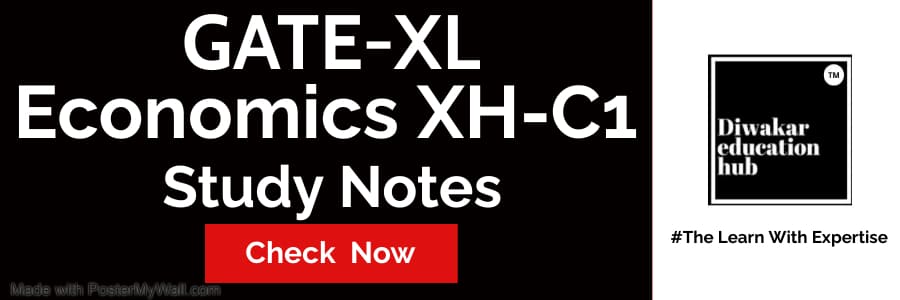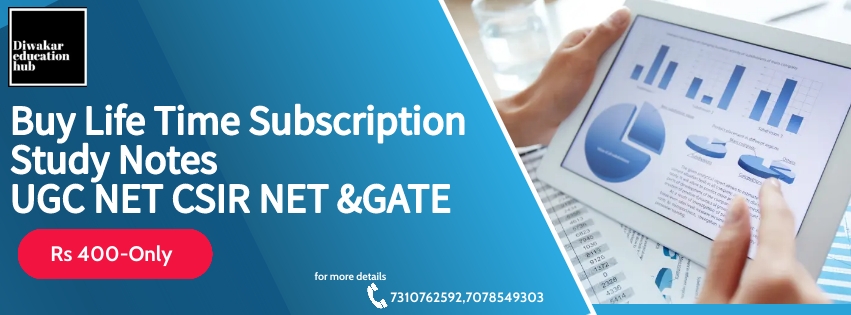
GATE Economics New & Revised Study Notes /Study Material As Per New Updated Syllabus 2025 [Complete 7 Units]
In This Article You Will Get Complete Study Notes & Material of GATE Economics Check Given Below
Gate Economics [Code -C1] Part of Optional Sections Paper XH (Humanities and Social Sciences)is One of The Important Exam of GATE, Subject Divided into 7 Chapters & Asked 40 Questions Based on MCQ,MSQ & NAT , 20 Questions Based on 1 Marks Each & Remain 20 Questions 2 Marks Each. Apart of That Reading Comprehension ( Compulsory ) Include 15 Questions Gives 25 Marks, & General Aptitude 10 Questions 5 Questions Based on 1 Marks Each & Remains 5 Question 2 Marks Each. Total 100 Marks Paper, Total 55 Questions Asked in Exam. Economics Subjects Based on Details Topics Like – Microeconomics, Macro Economics, Statistics, Econometrics and Mathematical Economics etc Syllabus is Lengthy & Paper Level is Moderate to Hard , In This Article You Will Get Complete Study Notes of GATE Economics Check Given Below
Here is Links of Read Economics GATE Complete Study Notes/ Study Material Check Complete Details Here
| Chapters /Links | Links to Read |
|---|---|
| Chapter -1 : Micro Economics | Click Here to Download |
| Chapter 2: Macro Economics | Click Here to Download |
| Chapter- 3 : Statistics, Econometrics and Mathematical Economics: | Click Here to Download |
| Chapters-4: International Economics | Click Here to Download |
| Chapters-5 : Public Economics | Click Here to Download |
| Chapters-6: Development Economics | Click Here to Download |
| Chapters -7 : Indian Economy | Click Here to Download |
| Total Chapters | 7 |
GATE Economics (Code -C1) Latest Syllabus-
| Units | Subjects / Topic Name |
| Chapter -1 : Micro Economics | Theory of Consumer Behaviour: Cardinal Approach and Ordinal Approach; Consumer Preferences; Nature of the utility function; Marshallian and Hicksian demand functions; Duality Theorem. Slutsky equation and Comparative Statics. Homogeneous and Homothetic Utility Functions; Euler’s Theorem. The Theory of Revealed Preference: Weak Axiom of Revealed Preference and Strong Axiom of Revealed Preference, Theory of Production and Costs: Short-run and Long-run Analysis, Existence, Uniqueness and Stability of Market Equilibrium: Walrasian and Marshallian Stability Analysis. The Cobweb Model, Decision making under uncertainty and risk. Asymmetric Information: Adverse Selection and Moral Hazard. Theory of Agency costs. The Theory of Search, Non-Cooperative games: Constant sum game, Mixed Strategy & Pure Strategy, Bayesian Nash Equilibrium, SPNE, Perfect Bayesian Equilibria., Theory of Firm: Market Structures — Competitive and Non-competitive equilibria and their efficiency properties. Structure-Conduct-Performance Paradigm, Factor Pricing: Marginal productivity Theory of Distribution in Perfectly Competitive markets; Theory of Employment in Imperfectly Competitive Markets — Monopolistic Exploitation, General Equilibrium Analysis. Welfare Economics: Fundamental Theorems, Social Welfare Function. Efficiency Criteria: Pareto-Optimality. |
| Chapter 2: Macro Economics | National Income Accounting: Closed Economy Concepts and Measurement and Open Economy Issues, Determination of output and employment: Classical & Keynesian Framework, Theories of Consumption: Absolute Income Hypothesis, Relative Income Hypothesis, Life Cycle Hypothesis, Permanent Income Hypothesis and Robert Hall’s Random Walk Model; Investment Function Specifications – Dale Jorgenson’s Neoclassical Theory of Capital Accumulation and Tobin’s, Keynesian Stabilization Policies, (Autonomous) Multipliers and Investment Accelerator, Demand and Supply of Money, Components of Money Supply, Liquidity Preference and Liquidity Trap, Money Multiplier, Interest Rate determination, Central Banking, Objectives, Instruments (Direct and Indirect) of Monetary Policy, Prudential Regulation, Quantitative Easing (Unconventional Monetary Policy), Commercial Banking, Non-Banking Financial Institutions, Capital Market and its Regulation, Theories of Inflation and Expectations Augmented Phillips Curve, Real Business Cycles, Adaptive Expectations Hypothesis, Rational Expectation Hypothesis and its critique. Closed Economy IS – LM Model and Mundell Fleming Model: Monetary and Fiscal Policy Efficacy. The Impossible Trinity. |
| Chapter- 3 : Statistics, Econometrics and Mathematical Economics: | Probability Theory: Concepts of probability, Probability Distributions [Discrete and Continuous], Central Limit Theorem, Index Numbers and Construction of Price Indices, Sampling Methods & Sampling Distribution, Statistical Inferences, Hypothesis Testing, Linear Regression Models and the Gauss Markov Theorem, Heteroscedasticity, Multicollinearity and Autocorrelation, Spurious regressions and Unit roots, Simultaneous Equation Models – recursive and non-recursive. Identification Problem, Differential Calculus and its Applications, Linear Algebra – Matrices, Applications of Cramer’s Rule, Static Optimization Problems and Applications, Input-Output Model, Linear Programming, Difference equations and Differential equations with applications |
| Chapters-4 : International Economics | Theories of International Trade, International Trade under Imperfect Competition, Gains from Trade, Terms of Trade, Trade Multiplier, Tariff and Non-Tariff barriers to trade; Dumping and Anti-Dumping Policies, GATT, WTO and Regional Trade Blocks; Trade Policy Issues, Balance of Payments: Composition, XH: Humanities and Social Sciences Equilibrium and Disequilibrium and Adjustment Mechanisms, Foreign Exchange Market and Arbitrage, Exchange rate determination, IMF & World Bank. |
| Chapters-5 : Public Economics | Public Economics: Market Failure and Remedial Measures: Asymmetric Information, Public Goods, Externality, Regulation of Market – Collusion and Consumers’ Welfare, Public Revenue: Tax & Non-Tax Revenue, Direct & Indirect Taxes, Progressive and non-Progressive Taxation, Incidence and Effects of Taxation, Public expenditure, Public Debt and its management, Public Budget and Budget Multiplier, Tax Incidence, Fiscal Policy and its implications, Environment as a Public Good, Market Failure and Coase Theorem, Cost-Benefit Analysis. |
| Chapters-6 : Development Economics | Development Economics: Theories of Economic Development: Adam Smith, David Ricardo, Karl Marx, J. Schumpeter, W. Rostow, Balanced & Unbalanced Growth, Big Push Approach, Indicators of Economic Development: HDI, SDGs, MDGs, Poverty and Inequalities – Concepts and Measurement Issues, Social Sector Development: Health, Education, Gender, Fertility, Morbidity, Mortality, Migration, Child Labor, Age Structure, Demographic Dividend, Models of Economic Growth: Harrod-Domar, Solow, Ramsey, Technical progress – Disembodied & Embodied, Endogenous Growth Models. |
| Chapters -7 : Indian Economy | Economic Growth in India: Pattern and Structure, Agriculture, Industry & Services Sector: Pattern & Structure of Growth, Major Challenges, Policy Responses, Rural & Urban Development – Issues, Challenges & Policy Responses, Flow of Foreign Capital, Trade Policies, Infrastructure Development: Physical and Social; Public-Private Partnerships, Reforms in Land, Labour and Capital Markets, Poverty, Inequality & Unemployment, Functioning of Monetary Policy in India, Fiscal Policy in the Indian context: Structure of Receipts and Expenditure, Tax reforms-Goods and Services Tax, Issues of Growth and Equity, Fiscal Federalism, Centre-State Financial Relations and Finance Commissions of India; Sustainability of Deficits and Debt, The Fiscal Responsibility and Budget Management Act 2003, Demonetization and aftermath. India’s balance of payments, Composition of India’s Trade, Competitiveness of India’s exports, India’s exchange rate policy. |

GATE Economics (C1) Important Topics Chapter Wise-
| Topics Included in GATE Economics Syllabus | Important-topics |
| Microeconomics | Theory of Consumer Behaviour, Consumer Preferences, Duality Theorem, Euler’s Theorem, The Theory of Revealed Preference, Walrasian and Marshallian Stability Analysis, Theory of Agency costs, rfect Bayesian Equilibria, etc. |
| International Economics | Theories of International Trade, Gains from Trade, International Trade under Imperfect Competition, Dumping and Anti-Dumping Policies. WTO, GATT, etc. |
| Developmental Economics | Theories of Economic Development, Indicators of Economic Development, Endogenous Growth Models, Disembodied and Embodied, etc. |
| Macroeconomics | National Income Accounting, Classical and Keynesian Framework, Absolute Income Hypothesis, Relative Income Hypothesis, Components of Money Supply, Theories of Inflation and Expectations, etc. |
| Public Economics | Market Failure and Remedial Measures, Regulation of Market, Public Budget and Budget Multiplier, Progressive and non-Progressive Taxation, Direct and Indirect Taxes, etc. |
| Indian Economy | Economic Growth in India, Functioning of Monetary Policy in India, Demonetization and Aftermath, Fiscal Policy in the Indian Context, etc. |
| Statistics, Econometrics & Mathematical Economics | Central Limit Theorem, Probability Theory, Linear Regression Models and the Gauss Markov Theorem, Multicollinearity and Autocorrelation, Heteroscedasticity, Static Optimization Problems and Applications, etc. |
Career Scope of Gate Economics 10 Opportunities –
- Career Scope After Qualified Gate Economics is Vast. You Can Apply in Many Job Profils Some Examples Given Below
- Govt. and private institution lecturer
- Doctor of Philosophy in economics
- Economist or finance employee in PSUs
- Trainer to economics students
- Economics books author and editor
- Career consultant
- The statistician in prestigious private & government organizations
- Project Associate, Project Fellow, Research Fellow, Project Assistant in Economics
- Economist in Agriculture, Finance, Labour, Business, Research, and International Fields
Frequently Asked Question GATE Economics
Q1. What is the GATE Cut Off for Economics 2023 ?
Ans – Here are Cut -off Marks & Highest Marks out of 100 GATE Exam 2023
| GATE Paper Code | Highest Score | Highest Marks (out of 100) | Cut-off Marks (out of 100) |
| XH-C1 (Economics) | 1000 | 62.67 | 29.4 |
| XH-C2 (English) | 986 | 77.67 | 41.7 |
| XH-C3 (Linguistics) | 1000 | 65.67 | 35.3 |
| XH-C4 (Philosophy) | 1000 | 71 | 37.9 |
| XH-C5 (Psychology) | 1000 | 77.33 | 48.5 |
| XH-C6 (Sociology) | 1000 | 66 | 34.3 |
Question -2 Are candidates allowed to use a physical calculator to solve long and complex calculations asked in GATE Question Paper?
Ans. All the candidates are provided with an online virtual scientific calculator to be used to answer the questions. However, it is important to understand that this virtual calculator would be available to use only in the selected questions and not in all the questions. This virtual calculator has the same capability as a scientific calculator
Question -3: Is there any eligibility criteria regarding the nationality of a candidate?
Ans: No, candidates from India as well as other countries can apply for GATE 2022.
Question -4: How is the GATE cutoff decided?
Ans- GATE cutoff is decided by considering various factors like number of applicants, availability of seats, difficulty level of exam and performance of candidates. The conducting institute decides the cutoff in consultation with other responsible authorities.
Question -5 How easy to crack GATE Exam?
Ans: Cracking any exam needs a lot of hard work, time management, dedication and proper use of resources. If you are dedicated to crack GATE, you can clear it easily.
| GATE Economics Syllabus | GATE Economics Eligiblity Criteria |
| GATE Economics Books | GATE Economics Career Scope |
Tag:ecoholics economics optional, gate economics book pdf, GATE Economics Books in PDF, GATE Economics Latest Notes, gate economics previous year question paper, GATE Economics Study Material, GATE Economics Study Notes, GATE Economics Syllabus, gate economics syllabus pdf, iit gate economics, ma economics entrance whatsapp group



